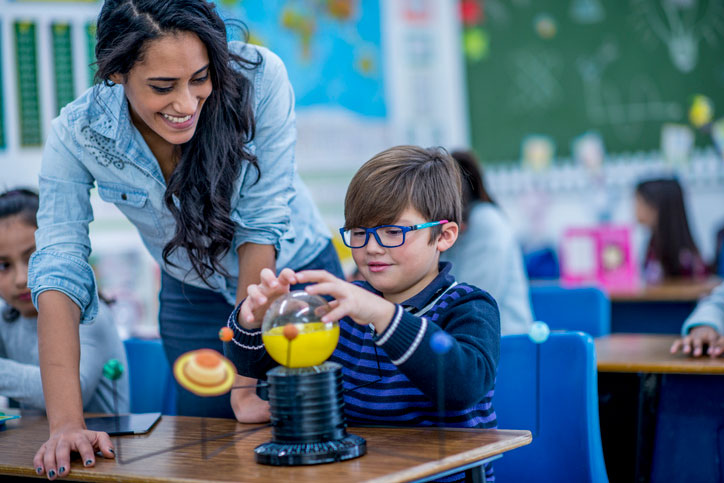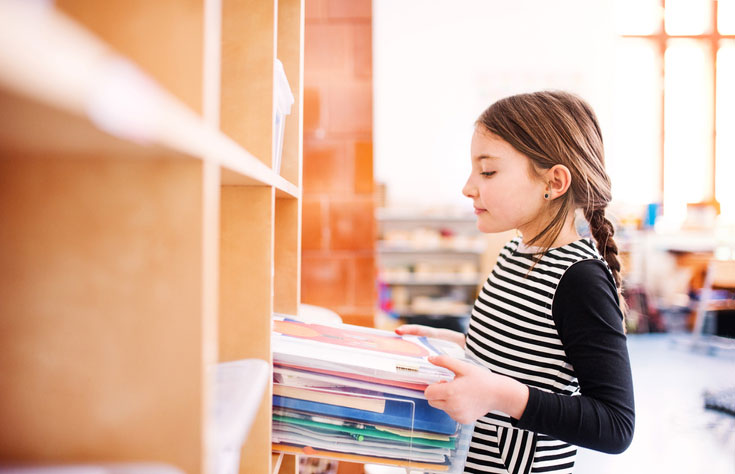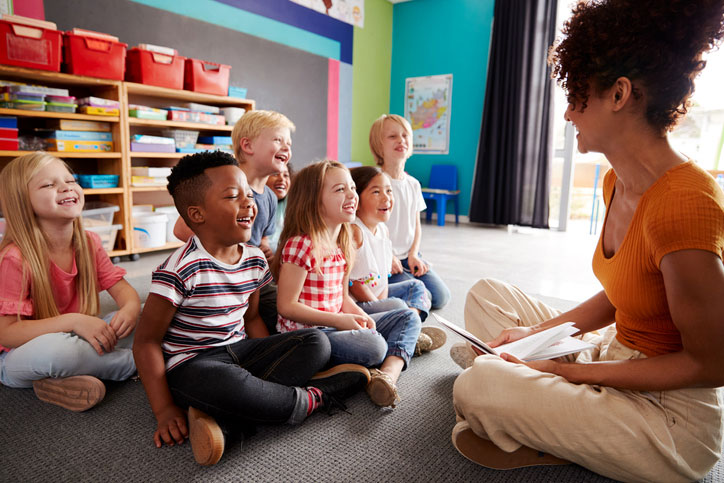Tips for Teaching Elementary Students: 6 Ways to Make an Impact
By Catherine Dorian – former English Teacher, Brattleboro Union High School and Fort Benton Middle/High School
August 24, 2021
We’ve all heard and read that teaching elementary students requires energy, creativity, and patience. There are a ton of ways to teach your content standards and a ton of ideas for how to teach elementary students. But you want to be a teacher who inspires your students to fall in love with learning. You want to reach every child. You want your students to come running to your classroom every morning, eager to know what you have planned for them for the day. You want to be the best that you can possibly so, that your students are also their best.
Wondering how to get the best results as a grade school teacher? Use these tips for teaching elementary students to ensure the best classroom experience.

1 – Fostering Safety and Structure is the Basis for Teaching Elementary Students
As a teacher and as an adult who has gone through several years of schooling, you are probably at this point familiar with how you learn best. But how do elementary students learn the best? One of the best ways to teach primary school students is to make them feel safe by providing structure for the day.
I once had a professor at my teacher education program in college say that your classroom should look like “organized chaos.” In other words, students should feel that the classroom is their home for learning, and they should have some ownership over the space. When they walk through the door, they should know where to hang their coat, what materials they should grab first, and where they are supposed to sit. They should be accustomed to a routine for each day, like when they’ll have their morning meeting and when they’ll work on different tasks. There should be some level of predictability and structure for the day so that they can have the freedom to explore learning, without the space or the day feeling jumbled.
Same goes for the physical setup. Spend the first few weeks prompting students to make the space theirs and to care about how it looks. Give each child a classroom job or task for the week, and make sure that you teach them how to do it properly so that they feel successful. Foster their independence by providing a sense of organization.
When students feel that they have structure in the classroom, they’ll feel safe coming to school every day. You want to keep things lively and interesting, but you want to establish a routine so that students feel like they are in charge of their learning.

2 – Being Flexible Is the Best Way to Teach Primary School Students
Remember that you are also working with a unique group of humans who are, well, human. Be prepared for them to have off days and on days. You may have students who come to school well-rested, fed, and adequately clothed; you may have other students who you know don’t have a proper winter coat and who experience more obstacles before the day has even started than other students will experience their entire childhood. Your job is to teach all these students and to reach their needs as best you can.
That means that oftentimes, you will need to be flexible about your expectations for the day. If the class is particularly rambunctious one day, you may benefit from taking them on a walk outside, and you may have to think on your feet about how to make the outdoor time relevant to your teaching standards. You may plan a lesson and begin teaching, only to soon realize that there were a set of standards that you should have covered beforehand and that your students aren’t yet ready to complete this activity.
Consider also your group dynamics in the classroom, which can shift and change from minute to minute. What happens on the playground or during lunch can and will drift its way into your classroom, depending on what you’re sensing from students, you may have to adjust your plans. On a broader scale, remember that your job is also dictated by events that you can’t control. The COVID-19 pandemic taught us all that sometimes, we’ll have to pivot our entire curriculum. Teaching online also taught us that there are many ways that we can incorporate technology thoughtfully and effectively. Learn to become comfortable with the wobble and learn to find fun and excitement in the challenge.

3 – Project-based Learning is One of the Best Teaching Practices for Elementary School
There are tons of curricular materials that you can purchase, find online for free, or build yourself, and nearly all of them will teach the standards that are required for your grade level. But what is most important to teach elementary students? One of the best things that we can teach students of all ages is to take ownership over their learning and to fall in love with inquiry. A great way to give some power back to your students and to help them see that learning is valuable is to incorporate project-based learning into your classroom.
Whether you call it Genius Hour, self-directed learning, or cross-disciplinary instruction, project-based learning means that you provide time for your students to explore a way of tackling a problem or answering a question. Start by modeling the process for students. Take something that you’re interested in—meditation, growing a small garden, or building a piece of pallet furniture, for instance—and show your students how you’re doing your research, planning your project, and testing out different methods. Then, provide time for your students to explore their interests. Show them how to take their curiosities and come up with a set of open-ended questions. Give them time to explore how to solve problems and create solutions. Allow them the flexibility to work independently or in groups.
There are many ways to incorporate project-based learning into your classroom and doing so is a proven method for teaching to an individual student’s needs and interests. The project-based approach is one of the best ways to teach primary school students to be lifelong learners and to fall in love with exploration, which are, after all, our central aims as teachers.

4 – Be Genuinely Interested in Your Students
Consider that there is one of you and twenty little humans who are relying on you to meet their needs. You are also being trusted by their parents, by your administrators, and by the general public to provide a learning environment that is safe, effective, and which prepares them for the future. You’ve been given a classroom and entrusted with the overall learning and well-being of perhaps as many as twenty-five little humans. As you prepare for the year, you probably have a million ideas of things that you could teach and lessons that could engage students. But since you work with humans, and since your job requires that you be adaptable, some of your success hinges on factors that you can’t control.
So how can a teacher, specifically one who works with young students, be effective in the classroom? If nothing else, and above all, your job is to make students fall in love with learning. Even if you can’t get every student to meet every benchmark by the predicted or desired deadline, you can at least create an atmosphere where they feel seen, heard, and valued. Get to know each of your students and see how you can incorporate their interests into the curriculum. Does one of your third graders love to spend time outside? Take the class to the woods behind school and give that child a leadership role for the day. Does one of your students happen to love video games? Ask them about it and see if there’s a way that you could structure their Genius Hour around solving the game or researching its invention. Either way, if you take genuine interest in your students, you’ll gain their trust, and you’ll be a more effective teacher as a result.

5 – Connect with Your Colleagues
There is a lot of information out there about what makes a good elementary school teacher. Remember, also, that there are thousands of elementary school teachers who are willing to give you ideas and advice. Don’t hesitate to reach out to your colleagues, whether in your immediate school environment, in your district at large, or via local, state, or national affiliations.
Join an online forum with elementary school teachers and even teachers in your specific grade level, where fellow teachers share ideas and ask for advice. Have lunch with your colleagues, and them what they think of your new idea for teaching the times tables. If you’re having trouble reaching one of your fourth graders, ask the third grade teacher who taught that child last year what they would recommend. Invite your principal, mentor, or curriculum coordinator in to see a lesson, and actively seek out their feedback.
Realize that you don’t have to know it all, and that you’re not expected to be perfect. As an elementary teacher, use your network to ensure that you’re incorporating best practices into your classroom.
Don’t forget that there are a whole host of professionals who have gone through what you’re going through and who are here to be your cheerleaders. You all have the same goal, which is to teach students the required standards and to help them fall in love with learning.

6 – Remember Why You Love Learning
You probably got into teaching for two reasons—you love kids, and you love learning. A love for learning is one of the keyqualities of a good teacher. Reconnect with why you love learning by attending conferences and workshops that challenge you and remind you why you love the process. Taking classes can not only bump you up on the pay scale, but they can keep your mind fresh and help you find new methods for teaching and keeping things interesting in the classroom. Not to mention, spending time with adults, whether networking or troubleshooting some of the challenges that you’re experiencing at your own school, is healthy for the teacher brain.
The bottom line: kindness, curiosity, and integrity are what make a good elementary school teacher. Know why you teach, and know how you want to structure your classroom. Also, know that you don’t have to know everything, and know that your primary goal is to get to know and to teach the most important people in your classroom: your students.
Interested in joining one of the most rewarding professions? Learn about how to become an elementary teacher here.
